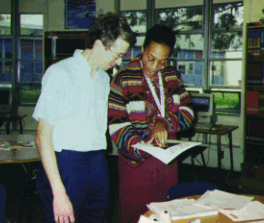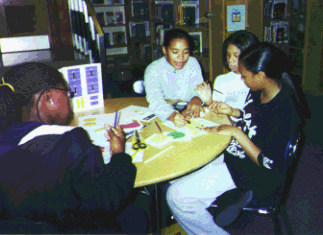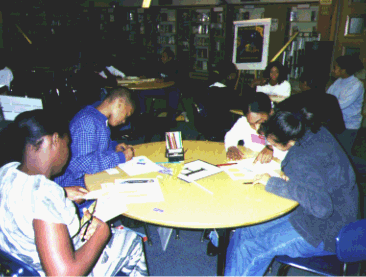For Educators
Jim and Maggie Visit Drew Freeman Middle School
|
On Nov. 10, 1999, Jim and Maggie went to visit Lisa Williamson's classroom at Drew Freeman Middle School. Lisa and fellow teacher Ms. Ethel Fitzhugh guided a class of 7th grade students through part of our brand new Journey of Discovery lesson.
|  |
The lesson (5 days long using a 90-minute block schedule) has students take on the role of light curve experts at the fictitious Drew Freeman Research Facility. On the first day of the lesson, the students receive an important bulletin from NASA. A mysterious X-ray source near the Galactic Center has been detected by the Rossi X-ray Timing Explorer (RXTE) satellite. The students collect, graph, and analyze data gathered by one of this satellite's scientific instruments, the All-Sky Monitor (ASM), to determine whether or not this source can be accurately identified as a black hole or a neutron star.
 |
Students complete a series of missions where they must perform tasks such as constructing a model of RXTE, creating a light curve from data collected by the ASM, interpreting, analyzing, and drawing conclusions from existing light curves, and using prior and acquired knowledge to identify the source of the X-ray emission. The culmination of the missions is a pretend space journey to the mystery source.
|
Students in classrooms with computer access should use the Student Adventure to guide them through the 5 missions. There is also a plain text Teacher Guide, an easily printable document that includes all the relevant information a teacher would need for this unit, including standards.
Though the 5 different missions were created to go together, as a unit, we have designed them so that they can each stand alone. Taken separately, each mission has a unique objective that will teach students something about how science and/or NASA works. However, when put together, the overall unit will give students a much broader perspective.
 |
When Jim and Maggie visited Drew Freeman Middle School, the students were working on Part 1 of the lesson - where the students construct a model of the RXTE. The students worked in groups of 4, each student taking on a different task, having to learn teamwork and patience - things that real world scientists and engineers need every day. Jim and Maggie also brought a 1/10th scale model of RXTE to show the class. By measuring the dimensions of the scale model, the class was able to figure out how large the real satellite is, something that left a big impression on the class.
|
|
Lisa told us, "It was a unique and exciting opportunity for our students to learn first hand from NASA scientists how spacecraft are actually constructed, to be able to learn about the teamwork that is necessary and the potential stumbling blocks that affect scientists and engineers when constructing a satellite." We enjoyed the experience ourselves - it's so interesting to watch a class try out something you've spent a lot of time developing - it gives you a good sense of what is good and what needs to be reworked. It's always a surprise to see what catches the students' interest - it's often something different than you would expect! |
 |
Maggie and Jim did a workshop featuring the "Journey of Discovery" lesson at the Spring 2000 National Science Teachers Association meeting (April 6-9) in Orlando, Fl.


